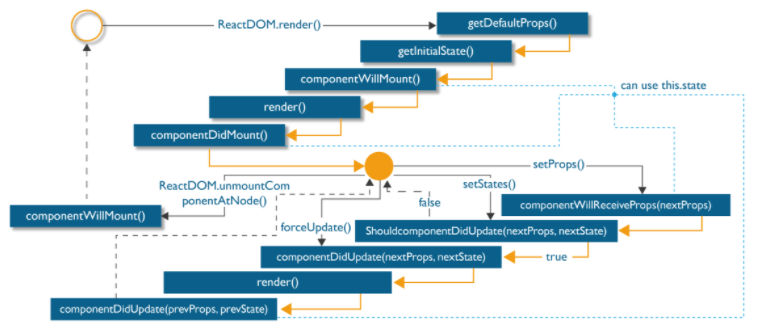Quick React
As Per Mdn docs:
The value of a const can’t be changed through reassignment, and it can’t be redeclared (i.e. through a variable declaration). However, if a const is an object or array its properties or items can be updated or removed.
React uses const in it’s components because components are destroyed and recreated(re-mounted) each render, NOT REASSIGNED !!
import React, { useState, useEffect } from 'react';Good links Implement the constructor behavior componentWillMount() into functional components as hooks

- React components have 2 parts
- localenv: local environment’s variable,hooks,functions
- JSX: the JSX or virtual DOM it returns.
Essence of React: 1 way data flow, localenv —-> JSX
useRef allows 2 way dataflow which is why it is advised against.
The moment we enter a new state, 0.1 and 0.2 is what happens first.
localenv behaves asynchronously Don’t trust your own ordering of ESPECIALLY WHEN INITAIZLING JSON variables because your INIT may depend on side effects it may mix side effects.
App = ({data}) => {
//data outputs some modified garbage data
//because of asynchronous side effect below
console.log(data)
/////////////////////////////////////////
const optionVar = {
price: SideEffectFunc(data)
//BIG NONO
}
/////////////////////////////////////////
return(..JSX..)
}
//1st fetches data from db
export async func getStaticProps(context){
const data = fetch(...)
return data
}Initializing a json “optionVar” but initialization depends on a sideeffect function. We expect data to output clean data but the “SideEffectFunc” already touched and corrupted our data. Server side on our console it looks like clean data BUT WHEN RENDERED USING chrome inspect we see data is actually modified
- DO NOT USE STATEFUL VARIABLES OR SIDE EFFECTS IN localenv
- DO NOT MODIFY THE “props” IN localenv
const App = () => {
//LOCALENV START ------------
console.log("0.1 render")
const hp, sethp = useState(() => 0)
const upgradehp() = {
console.log(hp) //2. outputs 0
sethp(prevhp => prevhp*2)
console.log(hp) //2. outputs 0
}//3. after running to completion our state update takes effect
//LOCALENV End --------------
//JSX START ------------------
return (
<div>
//1. click some button that calls upgradehp()
{console.log("0.2 render")}
{hp}
</div>
)
//JSX End --------------------
}Line 6 and Line 8 will always output the same value. The local env maintains some level of functional purity.
The pure upgradehp() function will run through completion (ignoring the state change of hp)
but after finishing it will signal to the JSX that hp state has changed and rerender the component to a new state.
In many ways the upgradehp() is similar to being an IO monad.
To understand react, trust that every function behaves in a functional deterministic manner wrt to it’s current state. (shown in line 6 and line 8)
0.0.1 When does React component rerender
- setState hook() is called
- All children of the component will also be rerendered
0.0.2 UseState
const hp, sethp = useState(() => 0)
const upgradehp() = {
sethp(prevhp => prevhp*2)
sethp(prevhp => prevhp*2)
}
...- DO pass a lambda function
prevhp => prevhp*2to setState - DO NOT do
sethealth(hp*2)- The behavior may be indeterminant if we called it twice like in the above code.
- we pass in a lazy function
() => 0on useState so that it isn’t called on every render.- Similar reason we pass a lazy callback function in jsx element like
onClick={(e) => doSomething()}
- Similar reason we pass a lazy callback function in jsx element like
0.0.3 UseEffect
useEffect(() => {
//Mount begin--------------
//setup event listener, subscribe api
//mount
console.log('target changed')
//Mount end----------------
//UnMount begin------------
return () => {
console.log('return from unmount changed')
//clean up event listener, unsubscribe api
//unmount
}
//UnMount end ------------
},
[] //target is empty
)- Mount - can only happen once
- Update - can happen as much as possible
- unMount - can only happen once
When UseEffect tracks a target or variable
- It will also call on mount/unmount but this time it will also call when the target is changed.
useEffect(() => {
// begin--------------
//on mount 1 call
//setup event listener, subscribe api
console.log('target changed')
// end----------------
// begin------------
return () => {
console.log('return from unmount changed')
//clean up event listener, unsubscribe api
//unmount
}
// end ------------
},
[target]
)0.0.4 UseRef
const App = () => {
const refContainer = useRef(null);
const onButtonClick = () => {console.log(refContainer.current)}
//refContainer.current will return the DOM object
return(
<>
<div ref={refContainer}>SomeText </div>
<button onClick={onButtonClick}>button</button>
</>
)
}line 7, the JSX <div ref={refContainer}> is what binds the ref Hook to the Dom Element.
In most cases of hooks like useEffect or useState, it’s the JSX element that depends on the hook.
But in this case the hook depends on the JSX element.